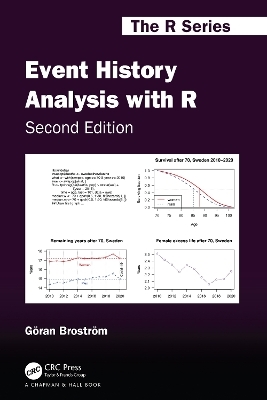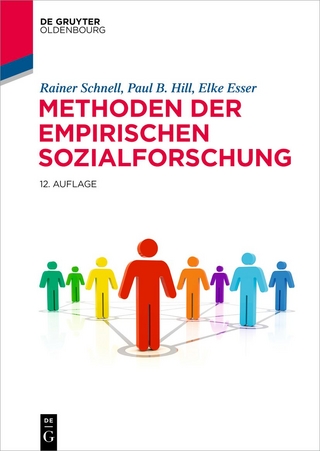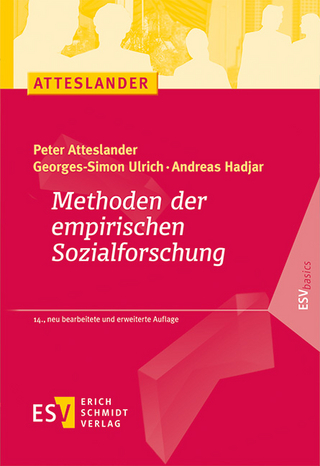
Event History Analysis with R
Seiten
2024
|
2nd edition
Chapman & Hall/CRC (Verlag)
978-1-032-12320-2 (ISBN)
Chapman & Hall/CRC (Verlag)
978-1-032-12320-2 (ISBN)
This is the second edition of a practical book on using R for survival and event history analysis. There is an emphasis on applying the methods to problems from the social sciences through detailed real-world examples. The book has been updated with new chapters on reproducible research and register-based methods, and updates throughout.
With an emphasis on social science applications, Event History Analysis with R, Second Edition, presents an introduction to survival and event history analysis using real-life examples. Since publication of the first edition, focus in the field has gradually shifted towards the analysis of large and complex datasets. This has led to new ways of tabulating and analysing tabulated data with the same precision and power as that of an analysis of the full data set. Tabulation also makes it possible to share sensitive data with others without violating integrity.
The new edition extends on the content of the first by both improving on already given methods and introducing new methods. There are two new chapters, Explanatory Variables and Regression, and Register- Based Survival Data Models. The book has been restructured to improve the flow, and there are significant updates to the computing in the supporting R package.
Features
• Introduction to survival and event history analysis and how to solve problems with incomplete data
using Cox regression.
• Parametric proportional hazards models, including the Weibull, Exponential, Extreme Value, and
Gompertz distributions.
• Parametric accelerated failure time models with the Lognormal, Loglogistic, Gompertz, Exponential,
Extreme Value, and Weibull distributions.
• Proportional hazards models for occurrence/exposure data, useful with tabular and register based data,
often with a huge amount of observed events.
• Special treatments of external communal covariates, selections from the Lexis diagram, and creating
period as well as cohort statistics.
• “Weird bootstrap” sampling suitable for Cox regression with small to medium-sized data sets.
• Supported by an R package (https://CRAN.R-project.org/package=eha), including code and data for
most examples in the book.
• A dedicated home page for the book at http://ehar.se/r/ehar2
This substantial update to this popular book remains an excellent resource for researchers and practitioners
of applied event history analysis and survival analysis. It can be used as a text for a course for graduate
students or for self-study.
With an emphasis on social science applications, Event History Analysis with R, Second Edition, presents an introduction to survival and event history analysis using real-life examples. Since publication of the first edition, focus in the field has gradually shifted towards the analysis of large and complex datasets. This has led to new ways of tabulating and analysing tabulated data with the same precision and power as that of an analysis of the full data set. Tabulation also makes it possible to share sensitive data with others without violating integrity.
The new edition extends on the content of the first by both improving on already given methods and introducing new methods. There are two new chapters, Explanatory Variables and Regression, and Register- Based Survival Data Models. The book has been restructured to improve the flow, and there are significant updates to the computing in the supporting R package.
Features
• Introduction to survival and event history analysis and how to solve problems with incomplete data
using Cox regression.
• Parametric proportional hazards models, including the Weibull, Exponential, Extreme Value, and
Gompertz distributions.
• Parametric accelerated failure time models with the Lognormal, Loglogistic, Gompertz, Exponential,
Extreme Value, and Weibull distributions.
• Proportional hazards models for occurrence/exposure data, useful with tabular and register based data,
often with a huge amount of observed events.
• Special treatments of external communal covariates, selections from the Lexis diagram, and creating
period as well as cohort statistics.
• “Weird bootstrap” sampling suitable for Cox regression with small to medium-sized data sets.
• Supported by an R package (https://CRAN.R-project.org/package=eha), including code and data for
most examples in the book.
• A dedicated home page for the book at http://ehar.se/r/ehar2
This substantial update to this popular book remains an excellent resource for researchers and practitioners
of applied event history analysis and survival analysis. It can be used as a text for a course for graduate
students or for self-study.
Göran Broström is professor emeritus of Statistics at the Centre for Demographic and Ageing Research, Umeå University. He has a PhD in mathematical statistics from Umeå University (1979). He is the author of two R packages, eha and glmmML, available on CRAN.
1. Event History and Survival Data
2. Single sample data
3. Proportional Hazards and Cox Regression
4. Explanatory Variables and Regression
5. Poisson Regression
6. More on Cox Regression
7. Register-Based Survival Data Models
8. Parametric Models
9. Multivariate survival models
10. Causality and Matching
11. Competing risks models
Appendix A. Basic statistical concepts
Appendix B. Survival distributions
Appendix C. A brief introduction to R
Appendix D. Survival packages in R
| Erscheinungsdatum | 14.11.2023 |
|---|---|
| Reihe/Serie | Chapman & Hall/CRC The R Series |
| Zusatzinfo | 72 Tables, black and white; 89 Line drawings, black and white; 89 Illustrations, black and white |
| Sprache | englisch |
| Maße | 156 x 234 mm |
| Gewicht | 489 g |
| Themenwelt | Geisteswissenschaften ► Psychologie |
| Sozialwissenschaften ► Soziologie ► Empirische Sozialforschung | |
| ISBN-10 | 1-032-12320-6 / 1032123206 |
| ISBN-13 | 978-1-032-12320-2 / 9781032123202 |
| Zustand | Neuware |
| Haben Sie eine Frage zum Produkt? |
Mehr entdecken
aus dem Bereich
aus dem Bereich
Buch | Hardcover (2023)
De Gruyter Oldenbourg (Verlag)
34,95 €
ein Arbeitsbuch
Buch | Softcover (2021)
De Gruyter Oldenbourg (Verlag)
34,95 €


